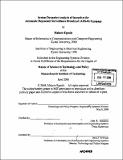| dc.contributor.advisor | John R. Hansman. | en_US |
| dc.contributor.author | Eguchi, Makoto | en_US |
| dc.contributor.other | Massachusetts Institute of Technology. Technology and Policy Program. | en_US |
| dc.contributor.other | Massachusetts Institute of Technology. Engineering Systems Division. | en_US |
| dc.date.accessioned | 2008-11-07T19:13:10Z | |
| dc.date.available | 2008-11-07T19:13:10Z | |
| dc.date.copyright | 2008 | en_US |
| dc.date.issued | 2008 | en_US |
| dc.identifier.uri | http://hdl.handle.net/1721.1/43184 | |
| dc.description | Thesis (S.M. in Technology and Policy)--Massachusetts Institute of Technology, Engineering Systems Division, Technology and Policy Program, 2008. | en_US |
| dc.description | Includes bibliographical references (p. 81-82). | en_US |
| dc.description.abstract | The demand for air transportation is anticipated to continue to grow in the future. In order to accommodate future demands, the U.S. Joint Planning and Development Office (JPDO) proposed the Next Generation Air Transportation System (NextGen). One of the NextGen technologies currently under development is Automatic Dependent Surveillance - Broadcast (ADS-B), which is a new satellite-based surveillance technology. In order to achieve the adoption of ADS-B, equipage by aircraft operators is essential. However, it is sometimes difficult to achieve the transition from a current technology to a new technology. Therefore, encouraging the individual user's adoption is a key factor of the successful technology transition. This thesis develops the system dynamics model to represent how individual users adopt a new technology, and analyzes how the adoption of new technologies can be encouraged using the system dynamics model. The effects of the following four incentive policies are examined: (1) Acceleration of operational benefits, (2) Preferred access, (3) Financial incentive, and (4) Mandate equipage. The result of the policy analysis shows the each incentive policy is effective to encourage the early adoption of ADS-B. Especially, achieving early benefits is important to accelerate equipage. Moving forward the mandate date of ADS-B equipage also can be effective to increase total benefits. | en_US |
| dc.description.statementofresponsibility | by Makoto Eguchi. | en_US |
| dc.format.extent | 82 p. | en_US |
| dc.language.iso | eng | en_US |
| dc.publisher | Massachusetts Institute of Technology | en_US |
| dc.rights | M.I.T. theses are protected by
copyright. They may be viewed from this source for any purpose, but
reproduction or distribution in any format is prohibited without written
permission. See provided URL for inquiries about permission. | en_US |
| dc.rights.uri | http://dspace.mit.edu/handle/1721.1/7582 | en_US |
| dc.subject | Technology and Policy Program. | en_US |
| dc.subject | Engineering Systems Division. | en_US |
| dc.title | System dynamics analysis of incentives for Automatic Dependent Surveillance Broadcast (ADS-B) equipage | en_US |
| dc.type | Thesis | en_US |
| dc.description.degree | S.M. | en_US |
| dc.contributor.department | Massachusetts Institute of Technology. Engineering Systems Division | |
| dc.contributor.department | Technology and Policy Program | |
| dc.identifier.oclc | 255597991 | en_US |
